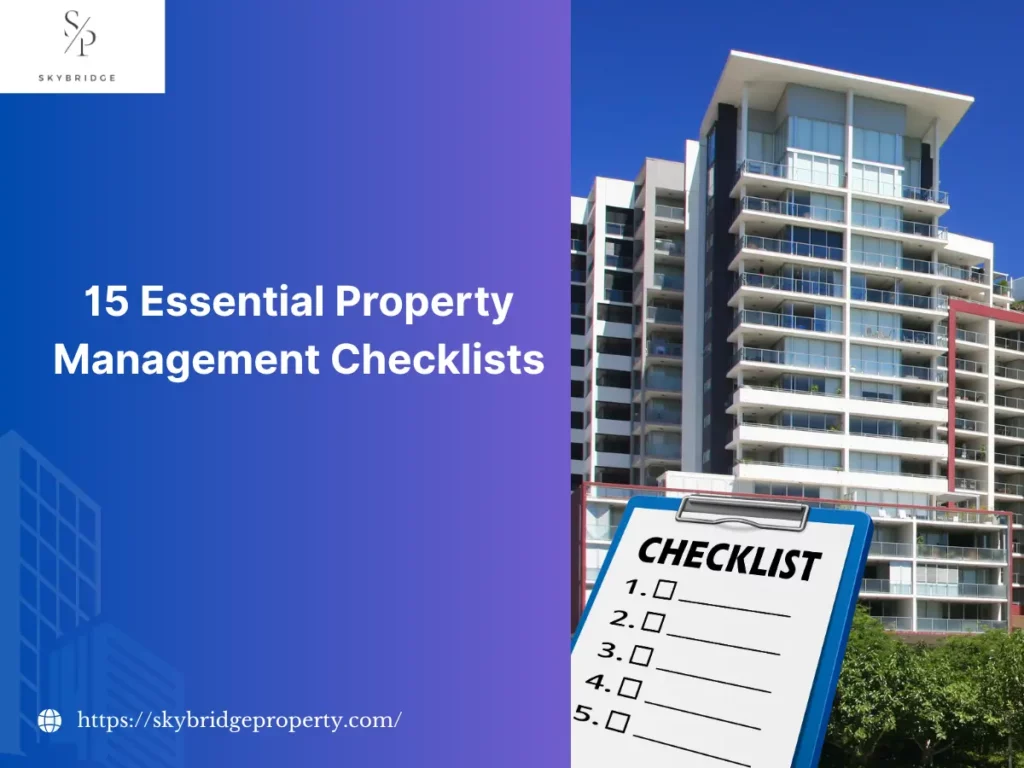A property management checklist is a structured list of tasks and verifications used to ensure consistent, legal, and efficient operations across all phases of property oversight. These checklists help landlords and managers bring consistency to complex tasks like tenant onboarding, maintenance scheduling, financial tracking, and lease transitions throughout the tenant lifecycle.
Used correctly, these tools help property managers avoid missed inspections, streamline tenant communication, and maintain habitability standards. By dividing tasks into categories that align with the tenant lifecycle, managers gain clearer oversight and improve service delivery.
Below is a summary of the 15 core checklists every property manager should use:
- Tenant Screening Checklist: Helps identify qualified renters by reviewing ID, credit, income, and rental history.
- Tenant Onboarding Checklist: Supports a smooth start by managing lease signings, key exchange, and utility setup.
- Lease Agreement Checklist: Ensures contract clarity by confirming rent terms, policies, and renewal conditions.
- Move-In Checklist: Documents the unit’s condition and verifies safety, cleanliness, and operational readiness.
- Property Inspection Checklist: Provides a routine check of structure, plumbing, HVAC, and pest conditions.
- Cleaning Checklist: Maintains hygiene by covering sanitation tasks before or after tenant occupancy.
- Maintenance Checklist: Tracks recurring and seasonal tasks to preserve property condition and habitability.
- Emergency Preparedness Checklist: Verifies readiness for fire, gas, or water-related incidents with plans and contact information.
- Health and Safety Checklist: Ensures legal habitability through mold, pest, and ventilation assessments.
- Tenant Communication Checklist: Standardizes notices, alerts, and updates across the lease term.
- Financial Checklist: Logs payments, deposits, and expenses to support budgeting and compliance.
- Legal Compliance Checklist: Confirms adherence to housing laws, licensing, and proper documentation.
- Move-Out Checklist: Guides the exit process through damage checks, final walkthrough, and deposit handling.
- Vacancy Preparation Checklist: Gets units market-ready with repairs, staging, and updated marketing material.
- Tenant Renewal Checklist: Reviews tenant history and updates lease terms before offering a renewal.
Tenant Screening Checklist
Screening prospective tenants is a foundational task that directly impacts property stability, rent consistency, and long-term occupancy. A well-structured checklist allows property managers to apply a fair and thorough evaluation process to every applicant, minimizing risk and aligning with legal standards for equal housing.
Key elements of an effective tenant screening checklist include:
- Proof of ID and residency: Verify applicant identity with valid government-issued documents.
- Completed application form: Confirm all required fields are accurately filled and signed.
- Credit and background check authorization: Secure written consent for official reports.
- Income and employment documents: Assess financial capability through recent pay stubs or employer verification.
- Rental history and references: Contact prior landlords to confirm tenant behavior and payment history.
- Criminal background check: Evaluate public safety risk based on permitted local criteria
- Co-signer or guarantor details: Collect supporting documentation if a co-signer is required.
- Pet policy acknowledgment: Ensure applicants agree to the stated pet rules and deposits.
Tenant Onboarding Checklist
Once a tenant is approved, onboarding becomes the next critical step to ensure a smooth transition into occupancy. A clearly defined checklist helps property managers deliver key documents, complete handovers, and establish communication while avoiding confusion or legal gaps.
Essential tenant onboarding tasks include:
- Signed lease agreement: Confirm all parties have reviewed and signed the rental contract.
- Emergency contact sheet: Collect and file up-to-date contact information for the tenant.
- Key release form: Document the handover of all keys, remotes, and access devices.
- Utility setup proof: Verify that the tenant has transferred or activated the necessary services.
- House rules and policies: Provide clear written expectations around noise, parking, trash, and guest limits.
- Move-in orientation: Walk the tenant through safety features, appliance use, and maintenance request procedures.
- Acknowledgment of received documents: Have the tenant confirm receipt of all onboarding materials.
Lease Agreement Checklist
The lease agreement outlines the legal relationship between landlord and tenant, making it essential that every term is clearly defined and acknowledged. A detailed checklist ensures that no critical clause is missed and that both parties understand their responsibilities before move-in.
Items to confirm during lease agreement setup include:
- Rent amount and due date: Specify monthly rent, payment schedule, and acceptable payment methods.
- Lease term and renewal options: Define the start and end dates along with any renewal conditions.
- Security deposit conditions: Clarify the deposit amount, holding process, and refund timeline.
- Maintenance responsibilities: Outline what the tenant must maintain and how repair requests are handled.
- Late fee policy: Include penalties, grace periods, and procedures for overdue rent.
- Occupancy limits: State who is allowed to live in the unit and guest policies.
- Pet policy and fees: Indicate whether pets are allowed and any related deposits or rules.
- Subletting and assignment terms: Address whether the tenant can transfer the lease.
- Termination and notice periods: Define the process and timing for ending the lease early or at term.
Move-In Checklist
Before a tenant occupies the property, a detailed move-in checklist ensures the unit is safe, clean, and fully functional. This process protects both landlord and tenant by documenting the initial condition of the space and setting expectations from the start.
Tasks to complete before handover include:
- Cleaning confirmation: Verify the entire unit is professionally cleaned and free of debris.
- Appliance and plumbing check: Test all fixtures, faucets, toilets, and major appliances for functionality.
- Electrical and lighting inspection: Ensure outlets, switches, and lights are operational and safe.
- Smoke and CO detector test: Confirm proper function and code compliance of all safety alarms.
- Photo documentation: Take timestamped photos of every room and appliance for condition records.
- Key and lock verification: Check that all keys are working and locks are secure.
- Utility transfer status: Confirm utilities are active in the tenant’s name or ready for transfer.
- Initial condition report: Complete a walkthrough with the tenant and collect signatures on a detailed report.
Property Inspection Checklist
Regular inspections help property managers maintain safety standards, ensure habitability, and catch repair needs before they escalate. A consistent checklist supports thorough reviews across all property areas, whether during move-in, move-out, or routine evaluations.
Important property inspection items include:
- Walls and flooring: Check for cracks, stains, water damage, or loose tiles and boards.
- Electrical system: Test outlets, circuit breakers, and visible wiring for safety and code compliance.
- Plumbing and drainage: Inspect faucets, drains, toilets, and water pressure for proper function.
- HVAC operation: Verify heating, ventilation, and cooling systems are functional and filters are clean.
- Roof and ceiling: Look for leaks, sagging, or signs of wear that could indicate structural issues.
- Pest and mold signs: Identify visible infestation or mold growth, especially in damp areas.
- Safety devices: Ensure smoke detectors, CO alarms, and extinguishers are present and tested.
- Photo documentation: Record the condition of each inspected area for comparison and liability purposes.
Cleaning Checklist
Cleanliness plays a vital role in tenant satisfaction and property upkeep, particularly during turnovers. A cleaning checklist standardizes tasks to ensure every room meets hygiene standards and is ready for move-in or re-listing.
Typical cleaning tasks include:
- Kitchen sanitation: Clean inside and outside of appliances, wipe counters, and degrease stovetops.
- Bathroom cleaning: Disinfect toilets, sinks, showers, and scrub grout where needed.
- Floor care: Vacuum carpets, mop hard floors, and treat stains or high-traffic areas.
- Appliance detailing: Remove residue and sanitize all interior and exterior surfaces.
- Window and glass washing: Clean panes, sills, and mirrors for a clear, polished look.
- Dusting and ventilation: Wipe down fans, vents, blinds, and baseboards.
- Trash removal: Empty all bins and remove any remaining debris from the unit.
- Surface disinfection: Sanitize handles, switches, and frequently touched areas.
Property Maintenance Checklist
Preventive maintenance helps extend property lifespan and minimize costly repairs. A maintenance checklist organizes recurring tasks, vendor coordination, and seasonal upkeep to ensure consistent property performance.
Core maintenance actions in a maintenance checklist include:
- Plumbing inspection: Check for leaks, clogs, and proper water pressure in all fixtures.
- HVAC filter replacement: Change filters on a regular schedule to maintain air quality and system efficiency.
- Electrical check: Test outlets, breakers, and fixtures to prevent hazards and outages
- Appliance functionality: Verify all major appliances are in working order and safe to use
- Roof and gutter review: Clear debris, inspect for damage, and check drainage systems
- Landscaping and curb appeal: Maintain lawns, trim overgrowth, and ensure walkways are clear.
- Seasonal tasks: Perform weather-related prep such as winterizing pipes or servicing cooling systems.
- Vendor scheduling and logs: Coordinate professional services and record dates, tasks, and outcomes.
Emergency Preparedness Checklist
Emergency preparedness ensures tenant safety and minimizes property damage during fires, natural disasters, or utility failures. A clear checklist helps property managers verify safety tools, set response procedures, and communicate protocols in advance.
Key components of the emergency preparedness checklist include:
- Fire evacuation plan: Provide clear exit routes and instructions for every unit or floor.
- Smoke and CO detector testing: Regularly verify that alarms are functioning and meet code requirements.
- Fire extinguisher placement: Ensure extinguishers are accessible, properly charged, and within expiration.
- Shut-off instructions: Label and document how to safely turn off gas, water, and electricity.
- Emergency contact list: Share names and numbers for building management, vendors, and local services.
- Tenant communication protocol: Clarify how alerts will be delivered in urgent situations.
- Signage and postings: Display exit maps, contact details, and hazard warnings in shared spaces.
- Preparedness review schedule: Set a timeline for reviewing and updating emergency plans.
Health and Safety Checklist
Maintaining health and safety standards is essential for legal compliance and tenant well-being. A focused checklist helps property managers identify hazards, meet housing codes, and prevent issues like mold, infestations, or unsafe conditions.
A health and safety checklist should include the following items:
- Ventilation assessment: Confirm that airflow is adequate and that fans or filters are functional.
- Mold and moisture check: Inspect walls, ceilings, and bathrooms for dampness or visible growth.
- Lead paint disclosure: Verify required disclosures for properties built before regulatory thresholds.
- Trip and fall hazard inspection: Look for loose flooring, poor lighting, or uneven surfaces.
- Smoke and CO alarms: Test detectors and replace batteries as needed.
- Pest control logs: Track treatments and monitor signs of infestation.
- Water quality check: Test water pressure, temperature, and clarity where applicable.
- Emergency access verification: Ensure hallways and exits remain unobstructed.
Tenant Communication Checklist
Clear and timely communication supports tenant trust and reduces misunderstandings throughout the lease term. A communication checklist ensures that key updates, notices, and responses are delivered consistently and documented properly.
Important tenant communication tasks include:
- Welcome letter delivery: Send a personalized introduction with key contacts and move-in information.
- Rent reminder notices: Issue monthly reminders before due dates.
- Maintenance alerts: Notify tenants of upcoming repairs or scheduled inspections.
- Emergency updates: Provide urgent information during utility outages or safety concerns.
- Complaint intake acknowledgment: Respond to tenant concerns with a timestamped confirmation.
- Lease change notifications: Share updates on policy changes or upcoming renewals
- Move-out guidance: Supply tenants with clear steps and expectations as their lease ends.
- Contact log maintenance: Record all communication touchpoints for future reference.
Financial Checklist
Accurate financial tracking is key to maintaining profitability and ensuring regulatory compliance. A structured checklist helps property managers monitor rent collection, handle expenses, and prepare for audits or tax filings.
Key items in a financial checklist include:
- Rent received log: Record all payments by date, method, and amount.
- Late fee tracking: Note overdue payments and applicable charges.
- Security deposit records: Document collected deposits and related refund terms.
- Maintenance expense log: Track service costs, receipts, and vendor payments.
- Vendor invoice filing: Maintain a system for logging and paying external service providers.
- Tax documentation: Gather records for annual filings, including 1099s and expense summaries.
- Budget planning sheet: Prepare monthly and annual forecasts based on income and costs.
- Digital accounting system: Use software or spreadsheets to centralize financial data.
Legal Compliance Checklist
Following housing laws and local regulations is essential for risk management in property operations. A legal compliance checklist helps property managers stay aligned with legal standards and avoid fines, lawsuits, or tenant disputes.
Checklist elements to verify legal compliance include:
- Fair housing compliance: Ensure screening, communication, and policies are applied equally.
- Lease legality review: Confirm contracts include required clauses and meet local standards.
- Eviction procedures: Follow proper steps for notices, documentation, and court filings.
- Safety disclosures: Provide required information on lead paint, mold, or nearby hazards.
- Notice periods: Comply with state or municipal timelines for entry, rent changes, or termination.
- Local licensing and registration: Verify the property meets all jurisdictional filing requirements.
- Data retention standards: Store tenant and financial records following applicable laws.
- Annual legal audits: Review documents and practices regularly for ongoing compliance.
Move Out Checklist
A move out checklist ensures the tenant exit process is smooth, documented, and fair. It helps property managers assess unit condition, finalize deposit decisions, and prepare the space for re-rental without delays.
Steps to complete at move-out include:
- Key and access return: Collect all keys, fobs, remotes, and entry devices.
- Final walkthrough inspection: Compare current unit condition with the move-in checklist.
- Damage documentation: Photograph any tenant-caused wear or violations.
- Cleaning verification: Confirm the unit meets cleanliness standards or arrange professional cleaning.
- Utility account status: Check that the tenant has canceled or transferred all utilities.
- Deposit evaluation form: Calculate deductions and prepare a return based on local law.
- Tenant forwarding address: Collect updated contact info for final correspondence.
- Exit acknowledgment: Have a tenant sign a form confirming the return of property and keys.
Vacancy Preparation Checklist
Preparing a unit for new occupancy is essential for minimizing vacancy time and presenting a clean, functional space to prospective tenants. A vacancy preparation checklist ensures that all maintenance, safety, and visual readiness tasks are completed before relisting.
Typical vacancy preparation tasks include:
- Deep cleaning: Sanitize all surfaces, appliances, and high-contact areas beyond standard turnover.
- Paint touch-ups or repainting: Refresh walls, trim, and ceilings where needed.
- Appliance and fixture repairs: Fix or replace anything not working or showing excessive wear.
- Pest treatment: Conduct preventative pest control to ensure a clean environment.
- Lock and key changes: Rekey or replace locks for security and legal compliance.
- Curb appeal updates: Tidy landscaping, clean walkways, and check exterior lighting.
- HVAC and plumbing checks: Confirm systems are operational and filters are replaced.
- Marketing materials: Capture updated listing photos and write fresh unit descriptions.
Tenant Renewal Checklist
Lease renewals offer a chance to retain reliable tenants while adjusting terms based on property needs or market trends. A tenant renewal checklist helps property managers evaluate performance, communicate options, and update agreements with minimal disruption.
Key steps in the tenant renewal process include:
- Renewal notice timing: Send notification 60 to 90 days before the lease end.
- Payment and behavior review: Evaluate rent history, complaints, and maintenance issues.
- Rent adjustment decision: Determine any increase based on market rates or property changes.
- Pre-renewal inspection: Check for damage or maintenance needs before extending the lease.
- Lease clause updates: Revise policies to reflect new terms or legal changes.
- Discussion with tenant: Confirm intent to renew and address any concerns.
- Updated lease signing: Complete and distribute the new agreement.
- Recordkeeping: Save signed documents and log the renewal in the tenant records.
How Professional Property Management Streamlines These Checklists?
Professional property management companies streamline property checklists by automating tasks, standardizing procedures, and ensuring regulatory compliance through dedicated systems. This leads to more efficient operations, fewer missed steps, and better documentation across all phases of the tenant lifecycle.
To ensure these benefits are consistently realized, Skybridge Property Group serves property owners across Los Angeles, Diamond Bar, Pomona, Rowland Heights, and La Puente by integrating checklists into digital workflows that automate reminders, track completions, and centralize documentation. This integrated approach includes portals and CRM tools that store lease documents, flag compliance requirements, and document interactions, ensuring all key actions like inspections, repairs, and renewals are completed and documented accurately.
Examples of how checklists are streamlined include:
- Automated inspection scheduling: Set recurring reminders and digital logs for routine checks.
- Vendor dispatch systems: Assign and track service requests with licensed professionals.
- Compliance audit logs: Maintain records for lease terms, disclosures, and license renewals.
- Digital recordkeeping: Store move-in forms, maintenance logs, and communication records in one system.
- Lease lifecycle tracking: Monitor key dates, rent status, and renewal timelines through dashboards.
Using a property management firm like Skybridge Property Group ensures checklists are implemented consistently and professionally, supporting long-term success and tenant satisfaction.







